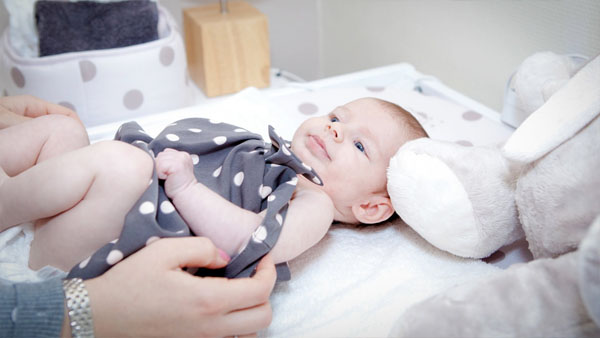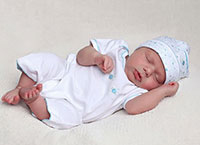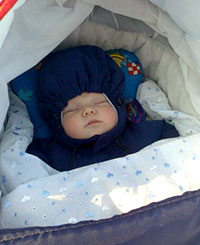Dressing a newborn. Properly dressed babies
From the very birth of your baby, every day during the first years of the little person’s life, you will ask yourself a question: How to dress my baby? To find the correct answer, you need to be a real strategist, as not only the temperature outside matters but also your baby’s age and weight, the daytime sleep duration, etc.

The younger your baby is, the worse is his ability to maintain the body temperature, and the faster he freezes or gets overheated.
Newborn’s dressing rules, regardless of the season.
There are a number of baby dressing rules, which are applicable to any season:
Baby’s underwear and the second layer of clothing should be only from natural fabrics. They provide water absorption and transport oxygen to the skin, protecting the baby from getting cold, skin irritation, sweat and overheating. To prevent skin allergies, you should try to choose minimum dyed underwear.
To protect delicate skin from damage, avoid rough seams, buttons, narrow and tight rubber bands, large zip fasteners, rigid lace and cutwork on the clothes that are in contact with the newborn baby’s body. Avoid underwear with decorative cuffs and tight collars. During the first two months of life (and for premature infants even longer), the best underwear for babies is with turned out seams.
Clothing should protect the baby from hypothermia. Infants body proportions differ from adults: the head and body surface area relative to internal organs is several times larger. Therefore, skin heat loss plays the main role in the heat-regulating mechanism. Due to the thermoregulation center immaturity, the temperature of the newborn’s body can decrease rapidly, especially in the wind or drafts. You should know the initial symptoms of hypothermia. They are:
- quiet plaintive cry,
- pale skin,
- red border of lips,
- marble pattern on the body,
- drowsiness,
- cold feet, legs, hands.
Parents should know that if a newborn baby’s body temperature is lower than 36.3 C (97,34 F), it is considered very low — the baby is freezing!
 The younger the baby is, the fewer areas of the body should be undressed. Therefore, newborn even indoors should wear a thin cap, and when going out, change the home cap to the appropriate warmer cap — flannel, wool or fur, depending on the weather. You should check that your newborn’s feet and hands are warm. Even while indoors, the baby should wear mittens and socks — cotton or wool. Chunky knit wool socks worn on bare feet can help your child struggle against neurological disorders, as they provide a permanent soft stimulation of important foot reflexogenic zones, and are a good option of relaxing the increased muscle tone.
The younger the baby is, the fewer areas of the body should be undressed. Therefore, newborn even indoors should wear a thin cap, and when going out, change the home cap to the appropriate warmer cap — flannel, wool or fur, depending on the weather. You should check that your newborn’s feet and hands are warm. Even while indoors, the baby should wear mittens and socks — cotton or wool. Chunky knit wool socks worn on bare feet can help your child struggle against neurological disorders, as they provide a permanent soft stimulation of important foot reflexogenic zones, and are a good option of relaxing the increased muscle tone.
Regarding walks in the open air, it is better to choose solid overalls to protect the child from accidental uncovering of back or tummy, and cooling, especially in windy weather. Clothes should not hamper the baby’s movements. Tight swaddling, wrapping in thick blankets and dressing in heavy clothing is already in the past. For balanced physical development and to be able to produce the necessary amount of heat, the child must be free to move actively. Clothes should not squeeze the body — so no narrow sleeves or pants.
Clothes should not be too loose, either. First, it will not protect the newborn from hypothermia, as it exposes too big areas of baby’s skin. Secondly, you’ll have to tuck the clothes, that will eventually hamper the arms and feet movements. So, every mom needs to learn to select clothes so that they are only slightly for growth. Baby clothes size is determined by only two parameters: chest circumference and height. During the first year of life, the child grows, on average, 25 cm taller, while in the first three months — up to 10 cm taller. Therefore, choosing new clothes, we can safely add to those 3−4cm to your baby’s real height in the first and 2 cm in the second half of the first year.
Clothing should be layered. The air gap between clothes effectively helps to maintain body temperature. It is better to wear two light than one thick sweater. However, it is important not to overdo, under the layers of clothing the baby should be able to move freely. You also need to consider the thermal conductivity of modern materials: the closer to the newborn’s body, the more hygroscopic and breathable must the fabric be.
When to start going for walks with a newborn?
If the child was born in summer, he is healthy and weighs over 3kg, then you can go out with your baby on the next day after the discharge from the hospital. However, to avoid overheating, the temperature outside should not exceed 29 degrees. To adapt your newborn to thermal conditions, start with a 15-minute walk every day and increase the duration of the walk by 15 minutes daily. Further, the length of being in the fresh air depends on the interval between feedings. You can go for a walk with your baby more than once a day.
If the child was born in autumn or spring, during the first week don’t go for walks with your baby in windy or rainy weather even if the temperature is OK. In such cases, adaptation should begin not earlier than three days after discharge from hospital with a 15-minute walk. Then increase the duration by 10 minutes daily up to 1.5 hours, if the air temperature is not below -5 degrees.
If the child was born in winter, then the first going out should be postponed at least for a week after your discharge from the maternity ward. The temperature should not be below -10 degrees for a baby younger than 2 months, and not less than -15 degrees at an older age. You should not risk the health of the baby and go for walks in strong wind or during a snowstorm. For adaptation, lasting for about 10 days, you need to choose quiet sunny days when the temperature is not below -5 degrees. The total duration of the walk can be up to one hour.
How to dress a newborn for walks in summer?
 As a rule, children under six months are carried in baby carriages or in slings, so they are protected from the wind. Therefore, you may dress your baby like indoors. A clean diaper, bodysuit with long sleeves, cotton mittens, sleeveless romper and cotton socks — will be optimal. To prevent overheating, it is better not to stay in the sun. The baby should wear a cap or Panama hat. Put breathable absorbent mat into the baby carriage. You can cover your sleeping baby with a cotton diaper (if the temperature is above +25 degrees) or with a terry sheet at +20.
As a rule, children under six months are carried in baby carriages or in slings, so they are protected from the wind. Therefore, you may dress your baby like indoors. A clean diaper, bodysuit with long sleeves, cotton mittens, sleeveless romper and cotton socks — will be optimal. To prevent overheating, it is better not to stay in the sun. The baby should wear a cap or Panama hat. Put breathable absorbent mat into the baby carriage. You can cover your sleeping baby with a cotton diaper (if the temperature is above +25 degrees) or with a terry sheet at +20.
At the age of 6 months, the duration of the period of active wakefulness in babies increases. On the one hand, it allows them to warm up and even sweat, on the other — it’s harder to protect them from wind and drafts. It is desirable that you take an extra set of clothes and always check your baby’s temperature and humidity of the skin. The best way is to touch your baby’s neck, if it is cold — you need to put on some more clothes. At the age of 6 months, rompers may be replaced with pants. If the baby gets sweaty — immediately change the clothes, because high humidity can lead to prickly heat or rapid hypothermia.
In calm sunny weather, short naked sunbathing will be useful for your child. For cool summer evenings, light wool bodysuits are perfect. General requirements for newborn clothes — maximum hygroscopicity and no synthetics.
How to dress a baby for walks in autumn?
The first layer of clothing is the diaper and cotton overalls or bodysuit with long sleeves, then goes a sleeveless romper. Further, when the air temperature is above 15 degrees, terry bodysuit and a terry hat will do; if above +10 — use wool or fleece sleeping bag; if the temperature is below 10 degrees — dress your baby in a warm overall, winter shoes or boots and thin wool hat with ties. Children up to 6 months need to wear thin gloves or mittens made of cotton. Sleeping in a stroller or a carriage the baby needs to be covered with a blanket. If you carry the baby in a sling jacket, dress your newborn somewhat cooler.
How to dress a baby for walks in the winter?
Regardless of the age and air temperature, the baby will need:
- fresh diaper (otherwise it’ll quickly cool);
- long sleeved cotton bodysuit or a t-shirt;
- fleece romper or warm tights;
- thin wool jacket;
- cotton or flannel cap;
- an additional mattress in the stroller made from sheepskin or thick wool.
Next put on:
 At temperatures above -5 degrees: A hat with ties, scarf, protecting the neck, wool mittens, warm winter overalls and natural fur boots. A great option for babies under three months is overalls-transformer with booties and mittens of the same material and insulation.
At temperatures above -5 degrees: A hat with ties, scarf, protecting the neck, wool mittens, warm winter overalls and natural fur boots. A great option for babies under three months is overalls-transformer with booties and mittens of the same material and insulation.
At temperatures from -5 to -10 degrees: wool knit jacket, pants, socks and scarf, insulated mittens, woolen double-layer cap, winter shoes, overalls with a woolen liner.
At temperatures below -10 degrees: warm wool suit or jumpsuit, fur mittens, hat, winter boots and a scarf. The insulation in overalls must be from natural wool or multi-layer synthetic filler. It’s also a great idea to use an insulated stroller, which better protects the baby from the chilly wind.
Don’t cover the newborn’s face with a blanket or scarf, as under them exhaled air accumulates. This creates additional humidity and increases the risk of frostbite skin damage. Just make sure that the baby is breathing through the nose and not crying. Don’t give your baby food or drinks in such cold weather.
In winter, it is very important to control the body temperature of your baby. For this mom needs to touch the baby’s skin in the neck area, forearms, or under the cap. If these areas are dry and warm, you can continue staying outside. If the baby is cold or wet, you need to return home to warm up or to change clothes.
How to dress your baby for walks in the spring?
Gentle spring sun can help your baby to saturate the body with vitamin D. Once the temperature exceeds the zero mark, you need to remove the liner in the overalls, take the warm mattress out of the stroller, change fur hat and mittens for insulated ones, and if plus 8 degrees – for fine woolen ones.
Spring strong contrasts of day and night temperature and cold winds and hot sun increase the risk of colds. Therefore, it is equally harmful to muffle up your baby and to remove the winter cap and overalls too early. It is better to gradually reduce the number of layers of clothing, to change the fabric to the lighter and do not forget to cover the sleeping baby with a blanket.
The above recommendations on choosing clothes for different seasons can’t take into account individual health status peculiarities of each newborn. Based on the recommendations, you must focus on the ability of your baby to regulate body temperature, and on the baby’s health condition.



